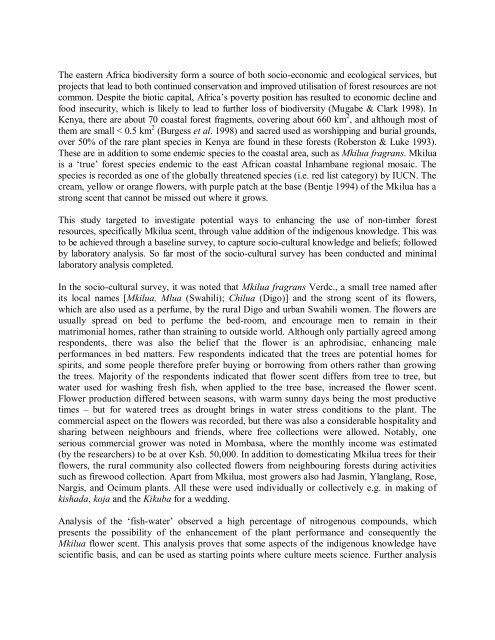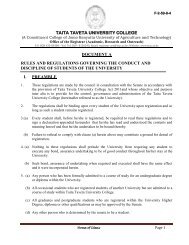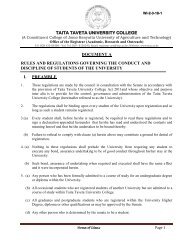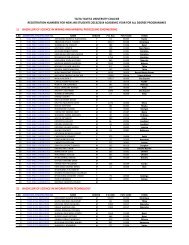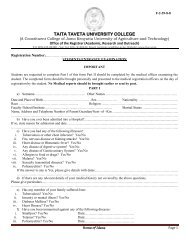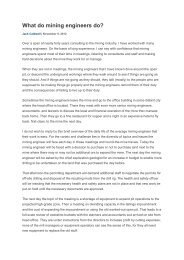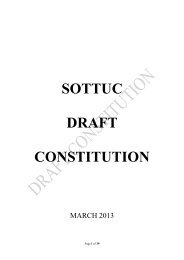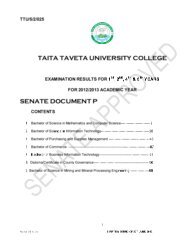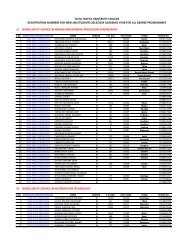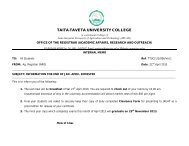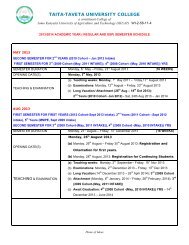Conference Book of Abstracts - Taita Taveta University College
Conference Book of Abstracts - Taita Taveta University College
Conference Book of Abstracts - Taita Taveta University College
- No tags were found...
Create successful ePaper yourself
Turn your PDF publications into a flip-book with our unique Google optimized e-Paper software.
The eastern Africa biodiversity form a source <strong>of</strong> both socio-economic and ecological services, butprojects that lead to both continued conservation and improved utilisation <strong>of</strong> forest resources are notcommon. Despite the biotic capital, Africa‟s poverty position has resulted to economic decline andfood insecurity, which is likely to lead to further loss <strong>of</strong> biodiversity (Mugabe & Clark 1998). InKenya, there are about 70 coastal forest fragments, covering about 660 km 2 , and although most <strong>of</strong>them are small < 0.5 km 2 (Burgess et al. 1998) and sacred used as worshipping and burial grounds,over 50% <strong>of</strong> the rare plant species in Kenya are found in these forests (Roberston & Luke 1993).These are in addition to some endemic species to the coastal area, such as Mkilua fragrans. Mkiluais a „true‟ forest species endemic to the east African coastal Inhambane regional mosaic. Thespecies is recorded as one <strong>of</strong> the globally threatened species (i.e. red list category) by IUCN. Thecream, yellow or orange flowers, with purple patch at the base (Bentje 1994) <strong>of</strong> the Mkilua has astrong scent that cannot be missed out where it grows.This study targeted to investigate potential ways to enhancing the use <strong>of</strong> non-timber forestresources, specifically Mkilua scent, through value addition <strong>of</strong> the indigenous knowledge. This wasto be achieved through a baseline survey, to capture socio-cultural knowledge and beliefs; followedby laboratory analysis. So far most <strong>of</strong> the socio-cultural survey has been conducted and minimallaboratory analysis completed.In the socio-cultural survey, it was noted that Mkilua fragrans Verdc., a small tree named afterits local names [Mkilua, Mlua (Swahili); Chilua (Digo)] and the strong scent <strong>of</strong> its flowers,which are also used as a perfume, by the rural Digo and urban Swahili women. The flowers areusually spread on bed to perfume the bed-room, and encourage men to remain in theirmatrimonial homes, rather than straining to outside world. Although only partially agreed amongrespondents, there was also the belief that the flower is an aphrodisiac, enhancing maleperformances in bed matters. Few respondents indicated that the trees are potential homes forspirits, and some people therefore prefer buying or borrowing from others rather than growingthe trees. Majority <strong>of</strong> the respondents indicated that flower scent differs from tree to tree, butwater used for washing fresh fish, when applied to the tree base, increased the flower scent.Flower production differed between seasons, with warm sunny days being the most productivetimes – but for watered trees as drought brings in water stress conditions to the plant. Thecommercial aspect on the flowers was recorded, but there was also a considerable hospitality andsharing between neighbours and friends, where free collections were allowed. Notably, oneserious commercial grower was noted in Mombasa, where the monthly income was estimated(by the researchers) to be at over Ksh. 50,000. In addition to domesticating Mkilua trees for theirflowers, the rural community also collected flowers from neighbouring forests during activitiessuch as firewood collection. Apart from Mkilua, most growers also had Jasmin, Ylanglang, Rose,Nargis, and Ocimum plants. All these were used individually or collectively e.g. in making <strong>of</strong>kishada, koja and the Kikuba for a wedding.Analysis <strong>of</strong> the „fish-water‟ observed a high percentage <strong>of</strong> nitrogenous compounds, whichpresents the possibility <strong>of</strong> the enhancement <strong>of</strong> the plant performance and consequently theMkilua flower scent. This analysis proves that some aspects <strong>of</strong> the indigenous knowledge havescientific basis, and can be used as starting points where culture meets science. Further analysis


